Scotland's Labour Market: People, Places and Regions - Statistics from the Annual Population Survey 2020/21
Summary publication of results from the Annual Population Survey 2020/21, presenting analysis on the labour market, education and training.
This document is part of a collection
Section 2: Type Of Work
2.1 Type of Employment
In April 2020-March 2021, an estimated 1,924,300 people aged 16 and over were in full-time employment and 664,400 people aged 16 and over were in part-time employment.
Over the year, the estimated number of people in full-time employment and part-time employment has decreased. For women, the estimated number in full-time employment has increased over the year while the number of women in part-time employment has decreased. For men, the estimated number in full-time employment decreased over the year while the number of men in part-time employment increased slightly.
In April 2020-March 2021, an estimated 25.7 per cent of all people in employment worked part-time, lower than the proportion of employed people working part-time in April 2019-March 2020 (26.9 per cent). This represents a statistically significant decrease.
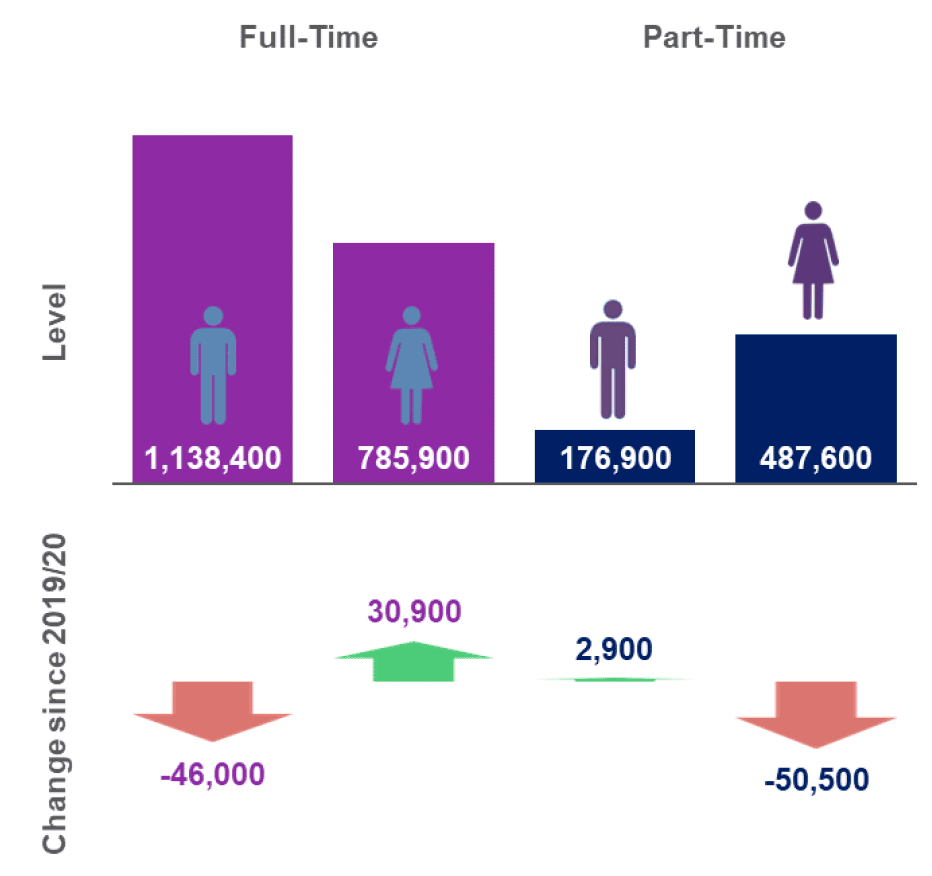
Source: Annual Population Survey, April-March datasets, ONS
Part-time employment accounts for a higher proportion of women's employment compared with men's; 38.3 per cent of all women's employment compared with 13.4 per cent of all men's employment.
Part-time employment is also more common for those in employment aged 16 to 24 years (46.5 per cent), with the majority being students, and for those aged 65 years and over where 57.2 per cent were working part-time.
Contractually Secure Employment
National Performance Framework Indicator
Contractually secure work
A Contractually secure worker is defined as an employee aged 16 and over who have a permanent contract.
In April 2020-March 2021, the proportion of employees aged 16 and over in contractually secure employment was estimated at 94.3 per cent, 1.0 percentage point lower than the estimated proportion in April 2019-March 2020 (95.3 per cent). This represents a statistically significant decrease. An estimated 129,700 employees aged 16 and over (5.7 per cent of all employees) were not in contractually secure employment in April 2020-March 2021. The main reasons given for not being in contractually secure employment were 'under contract for a fixed period or a fixed task' and 'working for an employment agency'.
Young people (16 to 24) were least likely to be in contractually secure employment. Across all age groups, the proportion of employees in contractually secure work is above 90.0 per cent, except for those aged 16 to 24 (87.8 per cent in April 2020-March 2021).
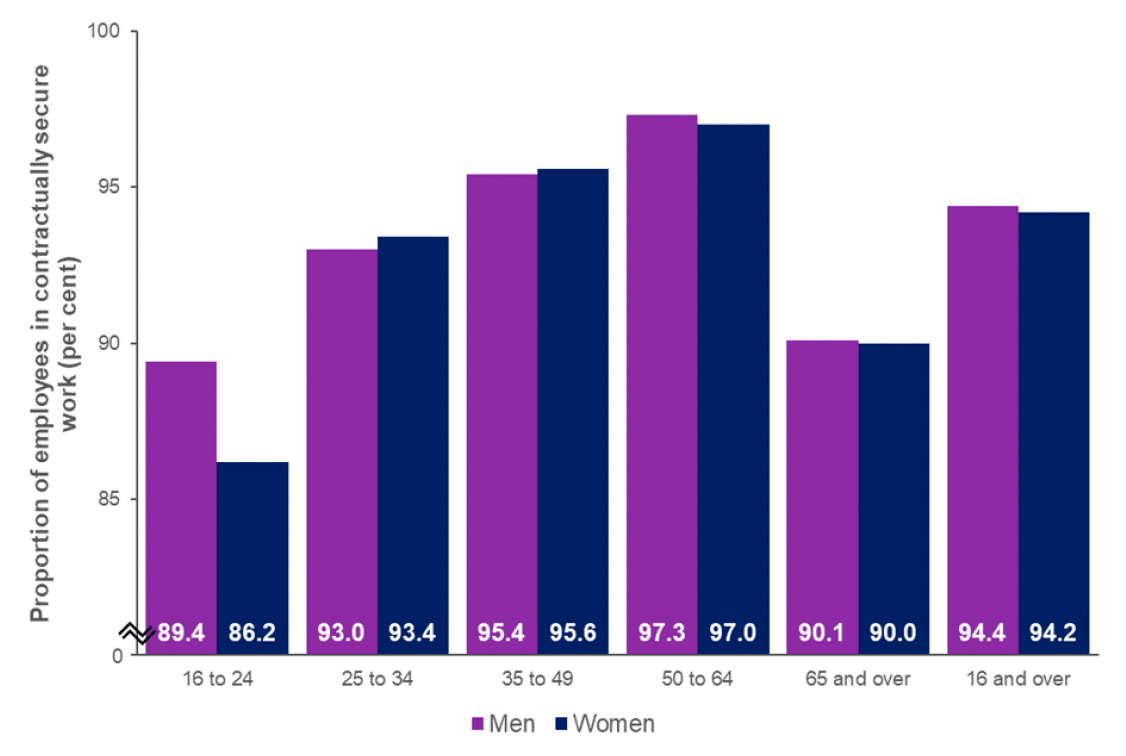
Self-employment
Note: There have been changes in self-employment in the last year due to self-employed people reporting that they are employees as they are using the Coronavirus Job Retention Scheme (CJRS) and this is affecting the continuity of the data.
In April 2020-March 2021, an estimated 292,800 people aged 16 and over in employment in Scotland were self-employed, 38,400 lower than in April 2019-March 2020 (331,200).
In the longer term self-employment has increased from a low of 246,800 in April 2005-March 2006 to a high of 331,200 in April 2019-March 2020. The pace of growth was faster than for employees overall and had been accounting for an increasing share of overall employment over time.
Self-employment accounted for 11.3 per cent of all employment in Scotland in April 2020-March 2021. This remains below the UK where 13.7 per cent of those in employment are self-employed.
Women accounted for an increasing share of self-employment from 26.7 per cent in April 2004-March 2005 to 38.7 per cent in April 2020-March 2021. In April 2020-March 2021, an estimated 113,400 women were classed as being self-employed, slightly lower than the year before (117,200 in April 2019-March 2020).
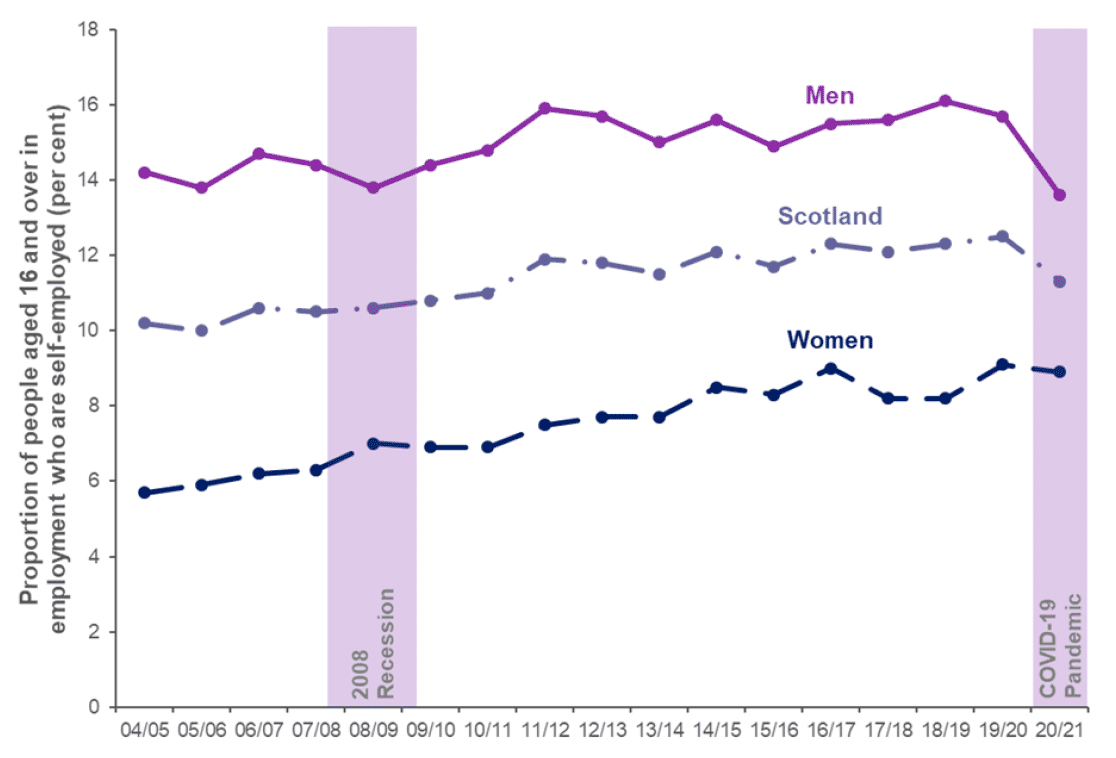
Source: Annual Population Survey, April-March datasets, ONS
The number of men in Scotland who are self-employed was estimated at 179,500 in April 2020-March 2021, lower than in April 2019-March 2020 when 214,000 men were self-employed.
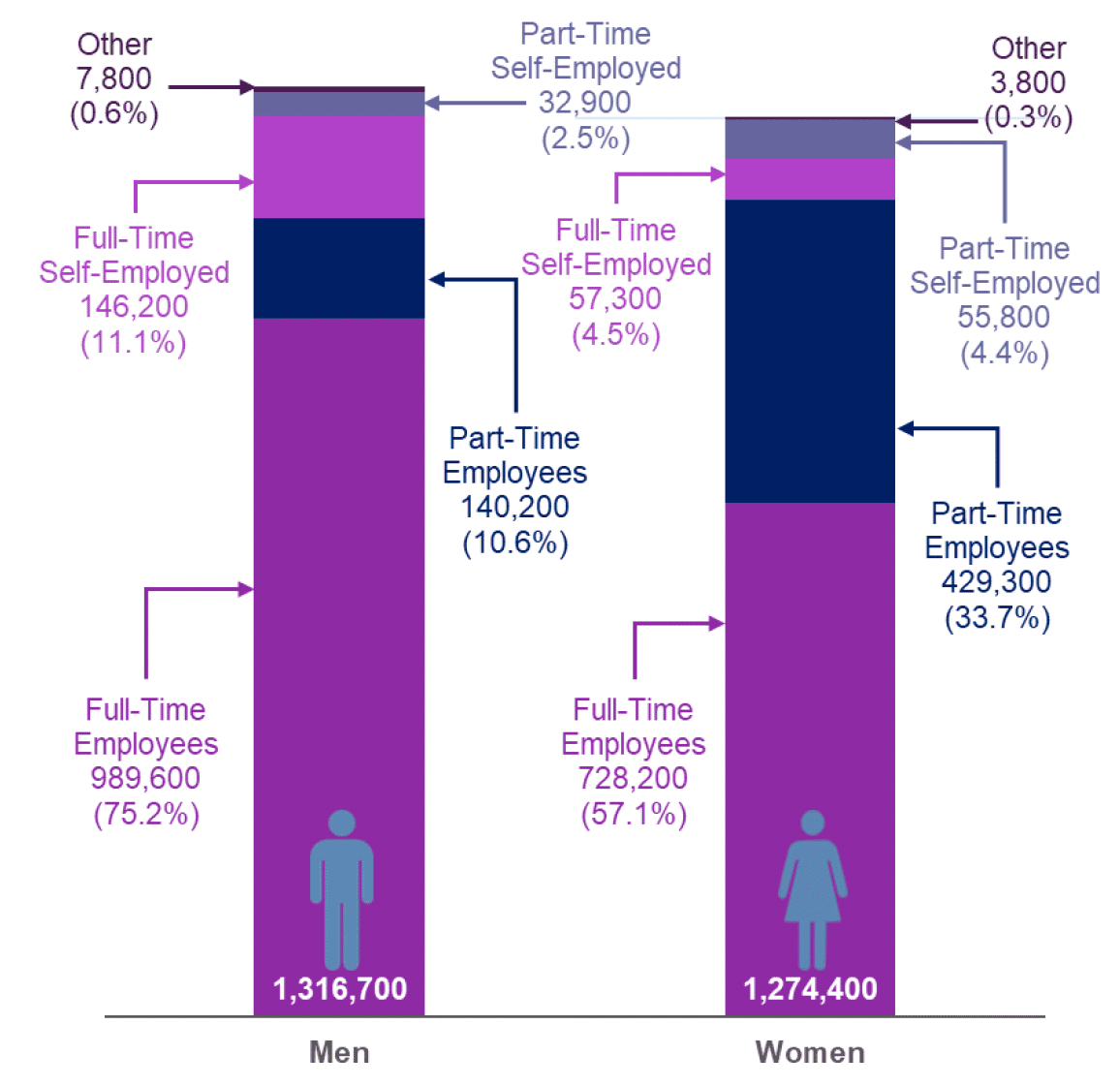
Notes: 1. Estimate for the 'Other' category for women is based on a small sample size. This may result in a less precise estimate which should be used with caution.
2. 'Other' is defined as those in Government employment & training programmes or unpaid family workers and employees and self-employed who did not report whether they worked full-time or part-time.
2.2 Underemployment
What is underemployment?
Underemployment refers to those who are in work but would prefer to work more hours in their current job (at their basic rate of pay), in an additional job or in a new job with longer hours to replace their current job. This provides a measure of underutilisation of labour.
The APS only collects information on hours based underemployment.
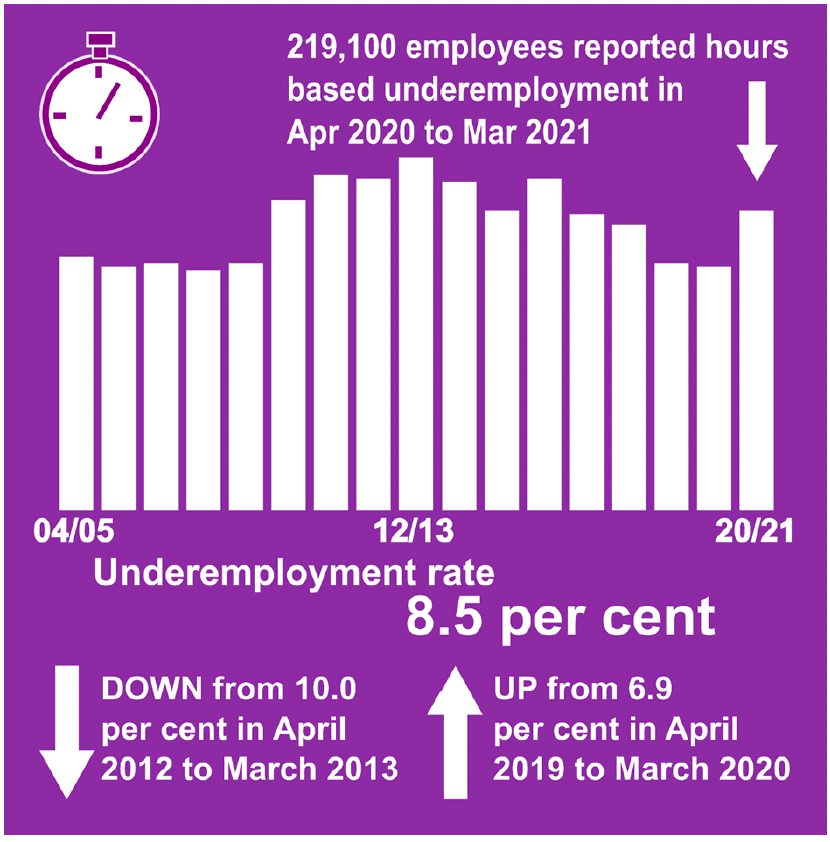
In April 2020-March 2021, it was estimated that 219,100 people in employment aged 16 and over were underemployed in Scotland, 36,800 more than in April 2019-March 2020.
In April 2020-March 2021, the underemployment rate (hours based underemployment as a percentage of all people aged 16 and over in employment) was estimated at 8.5 per cent, 1.6 percentage points higher than in April 2019-March 2020 (6.9 per cent). This represents a statistically significant increase over the year. However, it is still significantly lower than the peak rate of 10.0 per cent in April 2012-March 2013.
In April 2020-March 2021, it was estimated that the underemployment rate was higher for women (9.0 per cent) compared with men (8.1 per cent).
The underemployment rate for men aged 16 and over fell from its peak of 8.9 per cent in April 2010-March 2011 to 6.5 per cent in April 2019-March 2020. However, the underemployment rate for men in April 2020-March 2021 (8.1 per cent) is significantly higher than in April 2019-March 2020. The underemployment rate for women aged 16 and over fell from its peak of 11.4 per cent in April 2012-March 2013 to 7.3 per cent in April 2019-March 2020 which represents a statistically significant decrease. However, the underemployment rate for women in April 2020-March 2021 (9.0 per cent) is significantly higher than in April 2019-March 2020.
By age, the underemployment rate is estimated to be highest amongst those in employment aged 16 to 24 and at 19.7 per cent is over double the national average (8.5 per cent). In the period since April 2012-March 2013, the underemployment rate had decreased across all age groups to April 2019-March 2020. However, it has increased over the last year across all age groups.
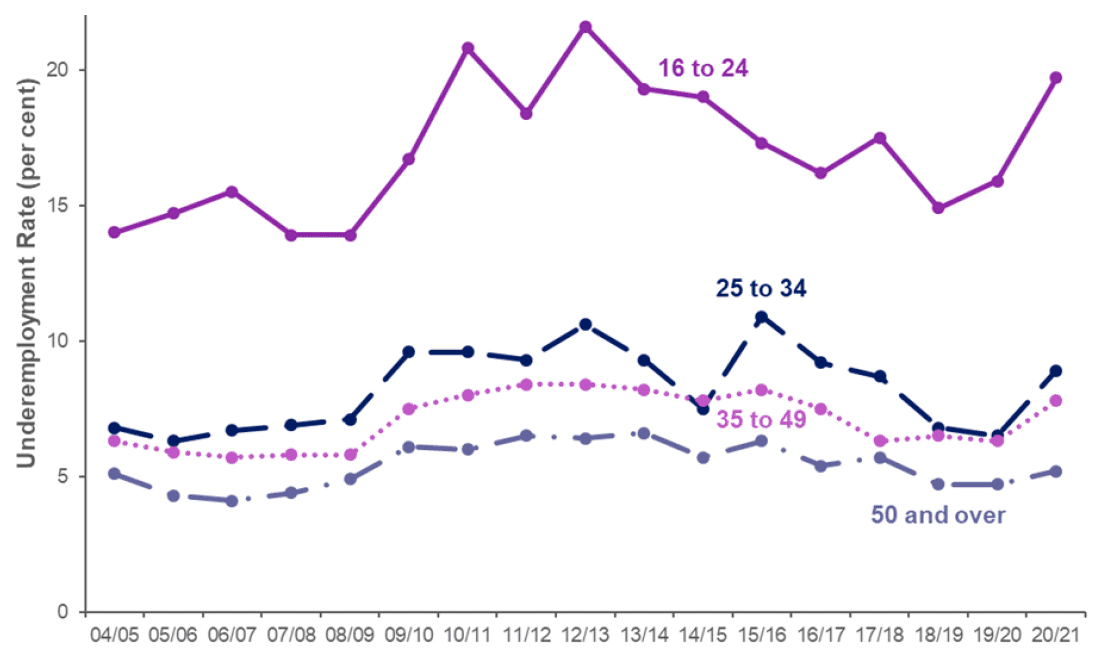
Source: Annual Population Survey, April-March datasets, ONS
Underemployment rate estimates have consistently been highest amongst men working part-time (30.2 per cent), followed by women working part-time (17.2 per cent) and lowest amongst women working full-time (3.9 per cent) and men working full-time (4.7 per cent).
The largest increase in underemployment over the last year, by sex and work pattern, was for men working part-time. In April 2019-March 2020, the underemployment rate for men working part-time was estimated at 23.4 per cent, rising to 30.2 per cent in April 20202-March 2021. This represents a statistically significant increase over the year.
Regional Variation
There is regional variation in the underemployment rate.
Estimates marked with an * indicate they are based on small sample sizes which may be less precise and should be used with caution.
In April 2020-March 2021, the local authority areas with the lowest underemployment rate estimates were:
- Highland (2.5* per cent);
- Falkirk (2.7* per cent); and
- West Lothian (4.9* per cent).
The local authority areas with the highest underemployment rate estimates were:
- East Ayrshire and City of Edinburgh (12.4 per cent);
- Fife (12.1 per cent); and
- Na h-Eileanan Siar (11.8* per cent).
In the last year, the underemployment rate has decreased in ten local authorities, increased in 22 local authorities.
The largest increases over the year were in:
- East Ayrshire up by 7.4* percentage points to 12.4 per cent;
- City of Edinburgh up by 6.2 percentage points to 12.4 per cent; and
These represent statistically significant increases over the year.
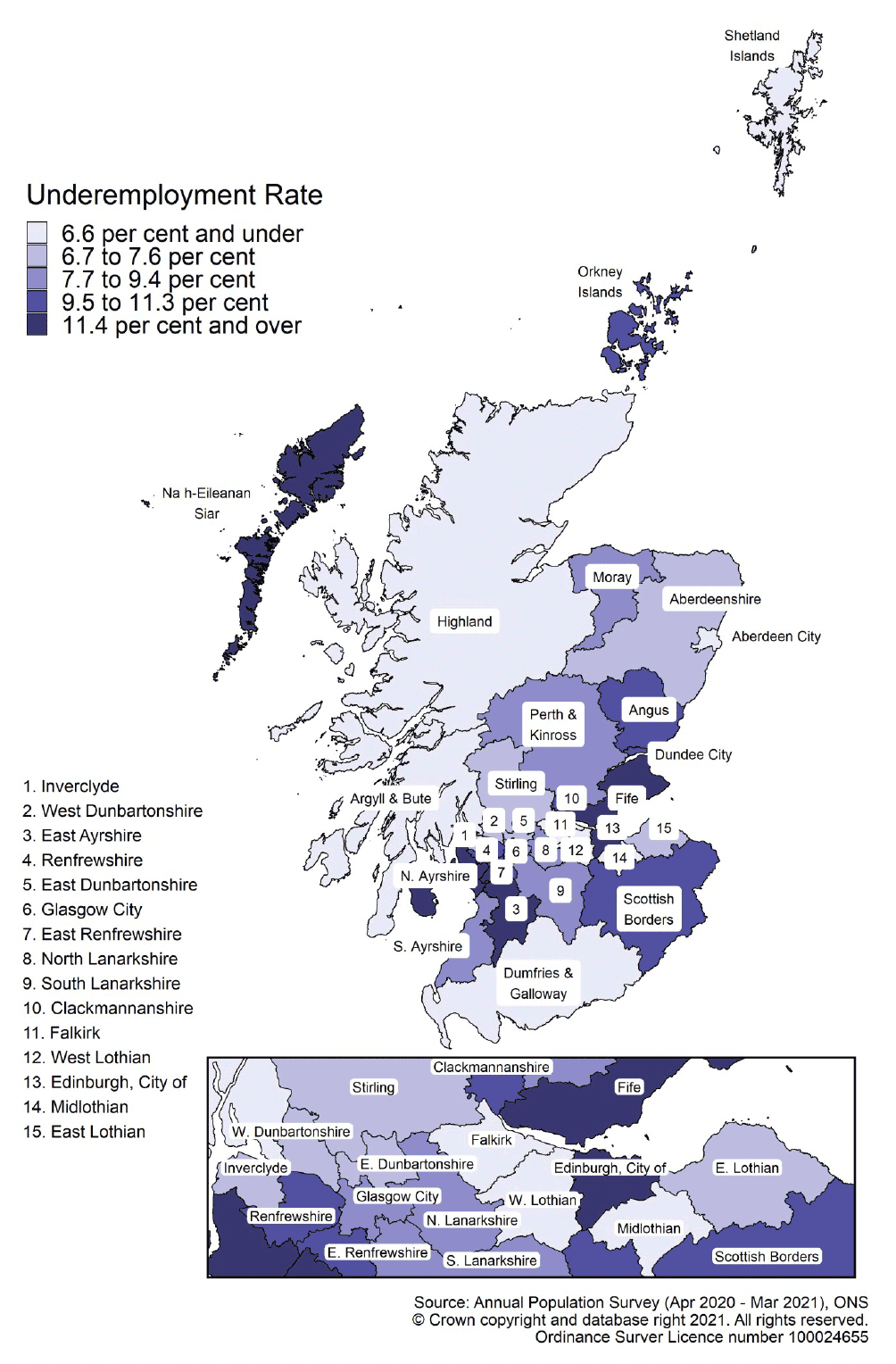
2.3 Employment by Sector
The official measure of public sector employment is the SG Quarterly Public Sector Survey. Estimates of employment by sector on the APS are based on survey respondents self-reporting
In April 2020-March 2021, Public Sector Employment accounts for an estimated 28.9 per cent of all in employment while private sector employment is 71.1 per cent of all in employment.
In April 2020-March 2021, the local authorities with the highest public sector employment estimates were:
- Na h-Eileanan Siar (40.4 per cent);
- Argyll & Bute (37.6 per cent); and
- West Dunbartonshire (36.8 per cent).
In the last year, there have been substantial movements in the number of people employed in certain sectors. The largest increases for employment by sex are within the "Education" and "Public Administration and Defence" sectors, with 39,900 more women employed in these sectors. (Note this is not the same as the Public Sector).
However, large changes over the year saw less women employed in the "Health and Social Work" (decreasing by 28,300), "Administration and Support Services" (decreasing by 16,700) and "Wholesale, Retail, Repair of Vehicles" (decreasing by 15,200) sectors.
While for men large decreases were seen in: "Construction" (decreasing by 37,100), "Manufacturing" (decreasing by 21,100) and "Wholesale, Retail, Repair of Vehicles" (decreasing by 13,200).
Employment for men increased for: "Information and Communication" (increasing by 13,600) and "Professional, Scientific, Technical Activities" (increasing by 8,700).
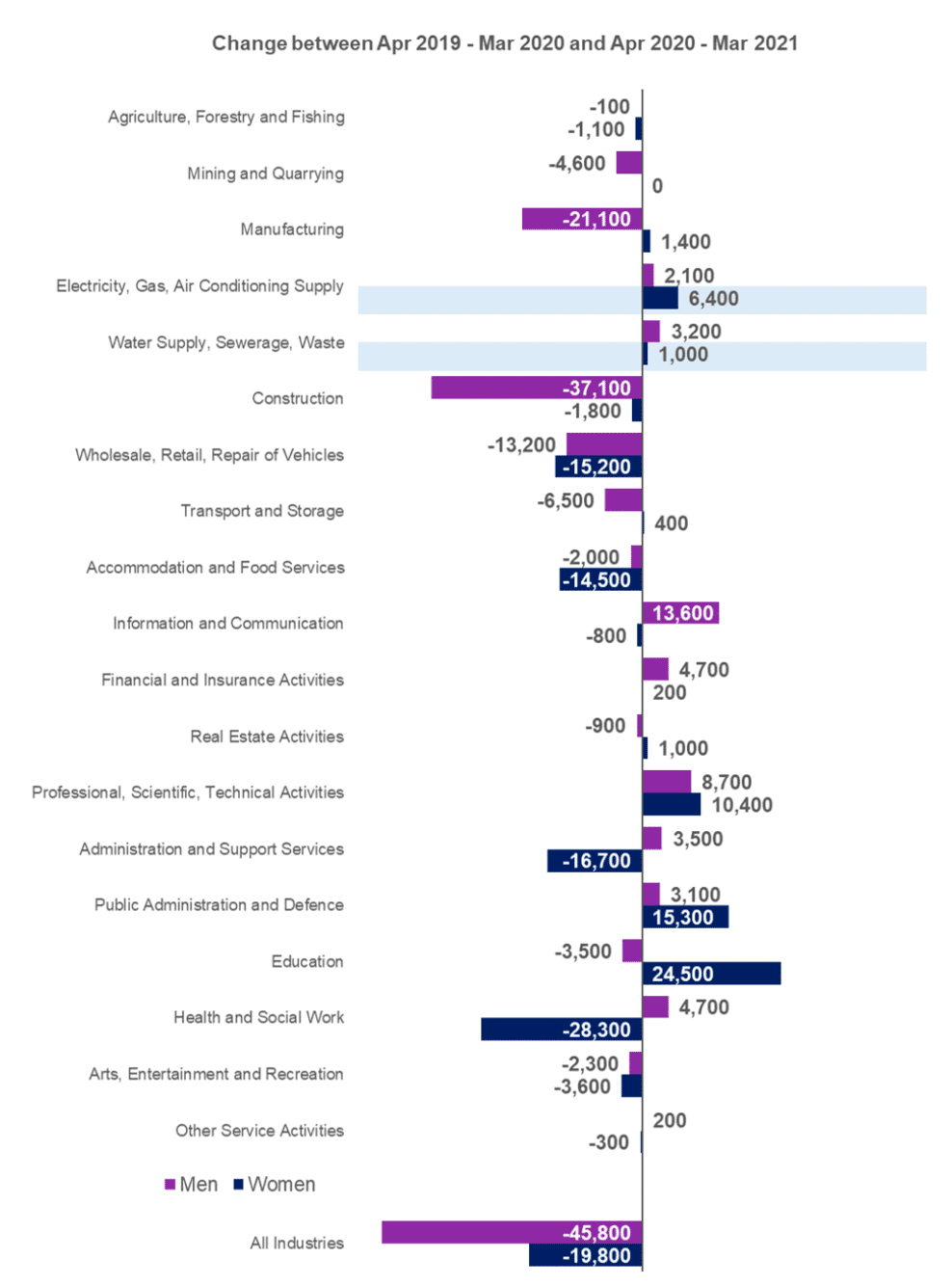
Note: A shaded background indicates estimates are based on a small sample size. This may result in less precise estimates, which should be used with caution.
2.4 Gender Segregation
Gender segregation remains a persistent issue across several broad industry sectors and occupational groups in Scotland.
Although equality legislation has been in place for many years, gender segregation is still apparent in many industry sectors in Scotland.
Almost half of all women in employment in Scotland (47.9 per cent) work in the "Public Administration and Defence", "Education", and "Health and Social Work" sectors (Note this is not the same as the Public Sector). Sectors with high levels of gender segregation towards women, this compares with around 20 per cent of men employed in these sectors.
Just under half (40.0 per cent) of men work in sectors that show high levels of gender segregation towards men: "Construction" (9.4 per cent), "Manufacturing" (10.1 per cent), "Transport and Storage" (6.9 per cent), Energy and water (6.4 per cent), "Information and Communication" (5.1 per cent) and "Agriculture, Forestry and Fishing" (2.2 per cent).
Gender segregation across the various occupational groups show a similar picture to that seen across industry sectors with specific occupational groups showing high levels of segregation.
40.1 per cent of women in Scotland were employed in occupations that are gender segregated towards women: "Personal Service Occupations" (15.3 per cent), "Administrative and Secretarial" (13.9 per cent) and "Sales and Customer Service Occupations" (10.9 per cent).
25.4 per cent of men in Scotland were employed in occupations that exhibit high levels of gender segregation towards men: "Skilled Trades Occupations" (15.7 per cent) and "Process, Plant and Machine Operatives" (9.7 per cent).

Note: A shaded background indicates estimates are based on a small sample size. This may result in less precise estimates, which should be used with caution.
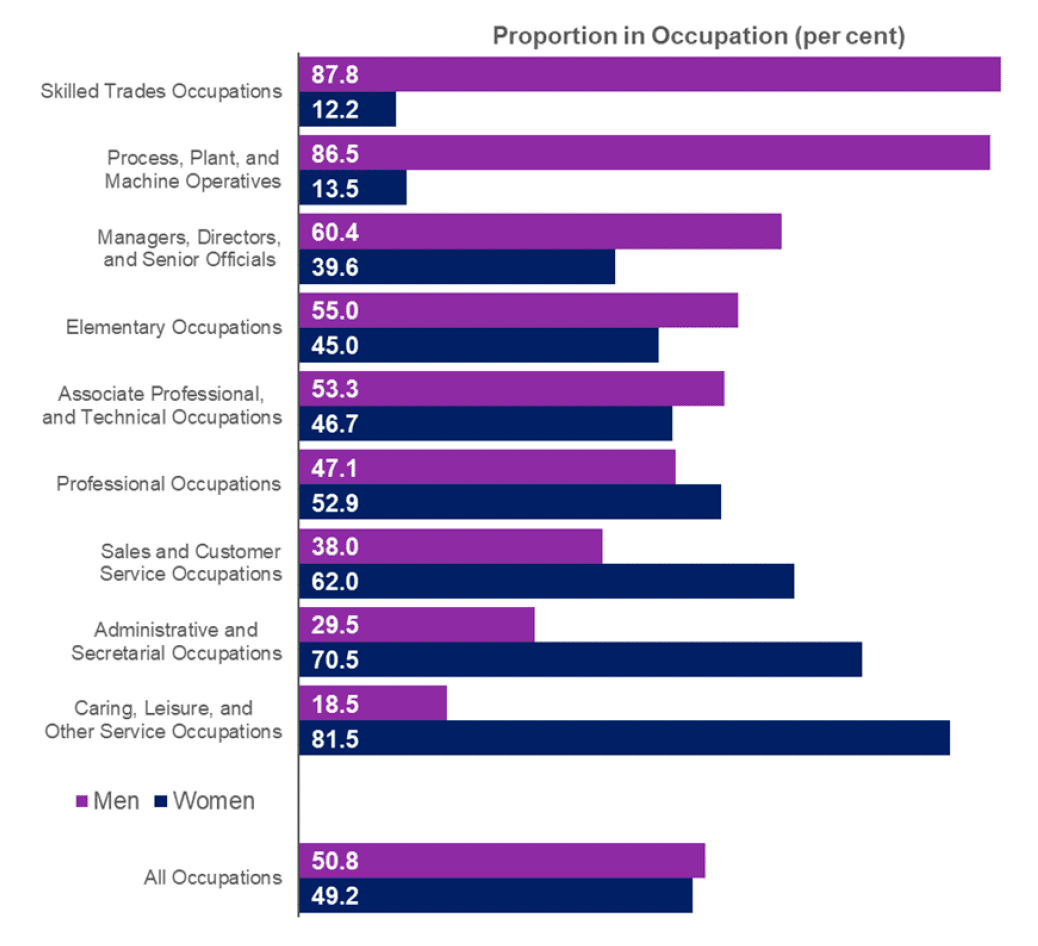
2.5 Job Related Training
National Performance Framework Indicator
Work place learning - have you taken part in any education or any training connected with your job or a job that you might be able to do in the future
Estimates marked with an * indicate they are based on small sample sizes which may be less precise and should be used with caution.
The percentage of people in employment aged 16-64 who reported receiving job related training in the last 3 months has been decreasing over time. In April 2019-March 2020, 24.1 per cent of people in employment were estimated to have received job related training in the last 3 months, decreasing to 22.0 per cent in April 2020-March 2021. This represents a statistically significant decrease.
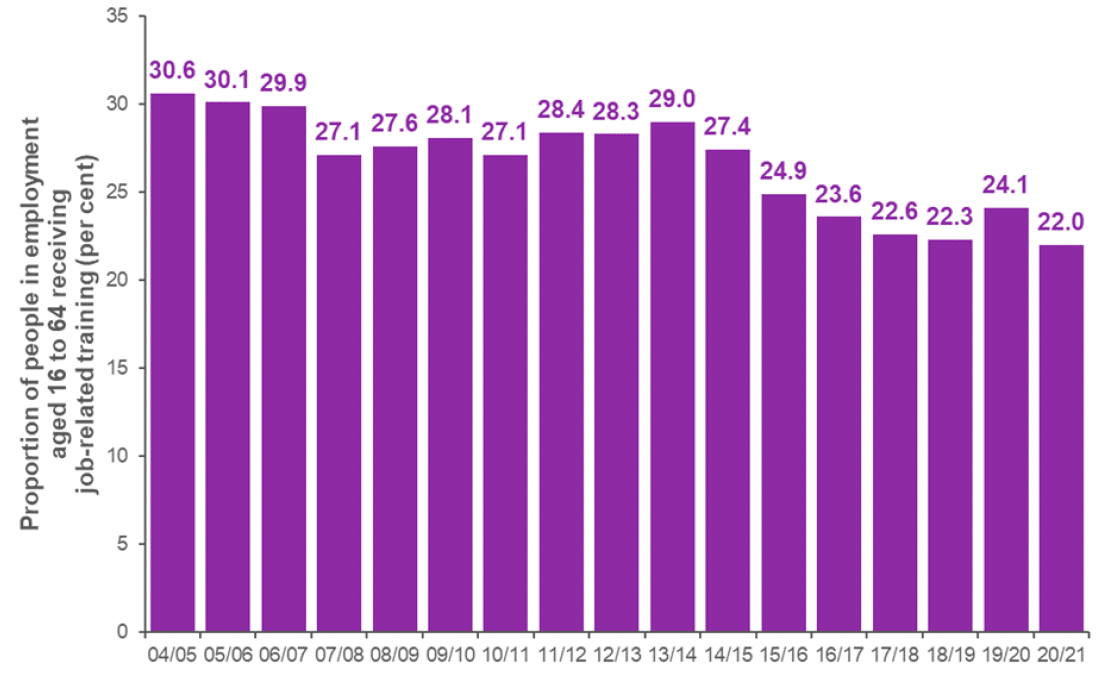
Source: Annual Population Survey, April-March datasets, ONS
In April 2020-March 2021, the local authorities with the highest proportion of people in employment aged 16-64 who reported receiving job related training were:
- Shetland Islands (31.3* per cent);
- Aberdeen City (29.9 per cent); and,
- Highland (29.8 per cent).
While the local authorities with the lowest proportion of people in employment who reported receiving job related training were:
- Scottish Borders and South Lanarkshire (13.0 per cent);
- West Dunbartonshire (15.3 per cent); and
- Falkirk (16.1 per cent).
In the last year, the proportion of people in employment who reported receiving job related training in the last 3 months has decreased in 22 local authorities and increased in 10 local authorities.
The largest decreases were seen in:
- Dundee City down by 11.4 percentage points to 22.8 per cent;
- Renfrewshire down by 9.2 percentage points to 21.8 per cent; and
- Angus down by 8.9 percentage points to 26.5 per cent.
These represent statistically significant decreases over the year.
In April 2010-March 2011, over a quarter of people in employment (27.1 per cent) were estimated to have received job related training in the last 3 months, decreasing to 22.0 per cent in April 2020-March 2021. This represents a statistically significant decrease.
Since April 2010-March 2011, the proportion of people in employment who reported receiving job related training in the last 3 months has decreased in 25 local authorities and increased in seven local authorities.
The largest decreases were seen in:
- South Lanarkshire down by 14.2 percentage points to 13.0 per cent;
- Scottish Borders down 14.0 percentage points to 13.0 per cent; and
- Fife down by 12.3 percentage points to 23.9 per cent.
These represent statistically significant decreases over the ten year period.
Contact
Email: lmstats@gov.scot
There is a problem
Thanks for your feedback